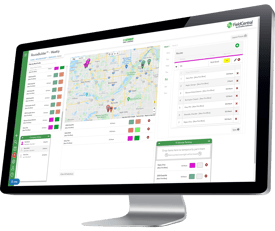Saving money is as good as making money. For your field service business to be successful, you need to locate areas where you can cut and consider spending in areas where you can expect a greater return. This requires some organization, research and sound oversight in order to optimize your field management. Read on to find tips on controlling overhead in order to continue building a better field service business.
-
Evolve into an eco-friendly office
First off, ask yourself is it necessary to have a downtown suite or storefront in general. If the work can be done from home, this is the most eco-friendly decision your business can make. No matter where the space is, take the everyday steps to keep it green: turn off all electronics at the end of the day, recycle and use LED lighting. Willing to go the extra green mile? Consider a do-it-yourself energy audit.
-
Hire a good accountant
When talking about cutting costs, it’s wise to look into where more can be spent. A good accountant is your best friend when looking to save money because they can spot deductions you wouldn’t be able to find even with a magnifying glass. Ask local small business owners for referrals or members of your Chamber or Commerce for an account best for your business.
-
Be smart about hiring
Keep your team lean and only hire when absolutely necessary. When you do look for an addition, seek a multitasking machine, meaning don’t hire someone with one skill set. If you want to go a step further and find your business suitable, consider hiring interns. This gives the student a priceless opportunity (literally) and time to grow into knowledgeable and experienced full-time employee.
-
Go paperless
Read on-screen and avoid printing by utilizing your email. If your business still uses a fax machine, set up a fax-to-email account at eFax or UnityFax so that messages are sent directly to your inbox rather than being printed out. The fee for an account is minimal and you will save more in the long run.
-
Say goodbye to the landline and consider VoIP
Cut the cord if you haven’t already. More than likely, most of your time is spent working out in the world away from the office and the desk phone, so outfit yourself and team with wireless communication. If your business is already equipped with cellphones, considering using VoIP (Voice Over Internet Protocol) if your plan includes data. This allows you to send and receive calls through your Internet connection instead of from your local phone company.
-
Review spending patterns
Piggy-backing off of #5, look over your phone plan. This is a major expense with a lot options to adjust such as switching to a family plan or pooling minutes. Also, be sure to log every transaction. A good way to make tracking expenses easier is to not pay with cash; using a card automatically keeps a record available for your review.
-
Do your research before you purchase
The Google machine is your best friend when trying to find what you’re looking for at the best price. If you discover something in store that you think will be beneficial for your business and budget, search for that product online and see if you can find it for cheaper. Check out Ebay or Amazon for starters. (Keep in mind shipping and handling could turn a steal into scandal, in which case it would be best to ditch the online option.)
-
Sell unwanted items on Craigslist
No one likes a hoarder, but it’s inevitable that we humans accumulate a lot of stuff in our lifetime. Getting rid of unnecessary or outdated items simply feels good, like a weight lifted off your shoulders. Even better is when those unwanted items still have some life left in them and you can get a little extra cash. It won’t be as much as you originally paid for, but it’s better than nothing.
-
Donate unwanted items to charity
If there are no bites on Craigslist after a month or so, donate. Giving back feels great and looks great for your company. Depending on whether the organization is eligible for a tax deduction, you can pocket some cash incentive for your generosity. Be sure to talk to that good accountant before considering this option.
-
Control inventory
Being organized makes this last step less of a hassle. Depending on how small your business is, tracking inventory can be done visually and order when you see fit. But this makes important data unavailable, like when purchases were made how much inventory was last ordered. There are many inexpensive point-of-sales apps available that double as an inventory management system, such as Inventory Tracker that can be used on your iPad.
For more tips on a successful field service business, download our free eBook today!









